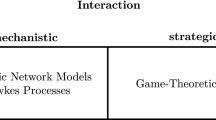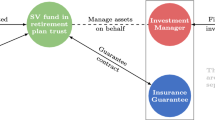Abstract
In this paper, we consider vulnerable options with jump risk and liquidity risk. In the proposed framework, we allow discontinuous changes in the information processes and the liquidity discount factors as well, and default risk is taken into consideration. Specially, we investigate the effect of jumps in the liquidity discount factors and find that the effects of jumps in the liquidity discount factors are stable for different maturities and alternative moneynesses. Further, option prices behave differently with respect to alternative intensities of common jumps, depending on whether there are jumps in the liquidity discount factors or not.










Similar content being viewed by others
Notes
A partial list of the studies on vulnerable European options includes Johnson and Stulz (1987), Klein and Inglis (1999, 2001), Liao and Huang (2005), Liang and Ren (2007), Yang et al. (2014), Lee et al. (2016), Niu and Wang (2016), Wang et al. (2017a), Wang (2017, 2018), Yang et al. (2019), and Liang and Wang (2020). In addition, there are a few papers focusing on vulnerable Asian options including Tsao and Liu (2012), Jeon et al. (2016) and Wang (2020a, 2020b).
In the proposed framework, the asymmetric effects of good versus bad news are not considered. The authors thank the referee for raising this issue. In order to investigate the asymmetric effects, we can consider the following dynamics,
$$\begin{aligned} L_1(t)= & {} L_1(0)\exp \Big \{ -\beta _1 \Big (\int _0^t a(s){\mathrm {d}}s + \int _0^t a(s) {\mathrm {d}}W(s)+ \sum _{k=1}^{N(t)}(\theta Z_k +\theta _a Z_k\mathbf {1}(Z_k<0))\Big )\Big \}, \end{aligned}$$where \(\theta _a\) is a non-negative constant. Obviously, with a positive value of \(\theta _a\), the effects of the positive and negative news on the liquidity discount factor are asymmetric. In Sect. 3, we will illustrate asymmetric effects on option prices numerically.
Monte Carlo simulation methods are used to obtain the option prices. The simulations are run with daily time steps and 25, 000 paths are generated for one price.
References
Acharya, V., & Pedersen, L. (2005). Asset pricing with liquidity risk. Journal of Financial Economics, 77, 375–410.
Amihud, Y., & Mendelson, H. (1991). Liquidity, asset prices and financial policy. Financial Analysts Journal, 47, 56–66.
Bakshi, G., Kapadia, N., & Madan, D. (2003). Stock return characteristics, skew laws and differential pricing of individual equity options. Review of Financial Studies, 16, 101–143.
Bates, D. (2008). The market for crash risk. Journal of Economic Dynamics and Control, 32, 2291–2321.
Bégin, J., Dorion, C., & Gauthier, G. (2020). Idiosyncratic jump risk matters: Evidence from equity returns and options. Review of Financial Studies, 33, 155–211.
Brunetti, C., & Caldarera A. (2006). Asset prices and asset correlations in illiquid markets. Working Paper.
Carr, P., Geman, H., Madan, D., & Yor, M. (2002). The fine structure of asset returns: An empirical investigation. Journal of Business, 75, 305–332.
Cruz, J., & Ševčovič, D. (2018). Option pricing in illiquid markets with jumps. Applied Mathematical Finance, 25, 389–409.
Elliott, R., Chan, L., & Siu, T. (2005). Option pricing and Esscher transform under regime switching. Annals of Finance, 1, 423–432.
Feng, S., Hung, M., & Wang, Y. (2014). Option pricing with stochastic liquidity risk: Theory and evidence. Journal of Financial Markets, 18, 77–95.
Feng, S., Hung, M., & Wang, Y. (2016). The importance of stock liquidity on opition pricing. International Review of Economics and Finance, 43, 457–467.
Fu, J., Wang, X., & Wang, Y. (2012). Credit spreads, endogenous bankruptcy and liquidity risk. Computational Management Science, 9, 515–530.
He, Z., & Milbradt, K. (2014). Endogenous liquidity and defaultable bonds. Econometrica, 82, 1443–1508.
He, Z., & Xiong, W. (2012). Rollover risk and credit risk. Journal of Finance, 67, 391–429.
Jeon, J., Yoon, J., & Kang, M. (2016). Valuing vulnerable geometric Asian options. Computers and Mathematics with Applications, 71, 676–691.
Johnson, H., & Stulz, R. (1987). The pricing of options with default risk. Journal of Finance, 42, 267–280.
Klein, P. (1996). Pricing Black–Scholes options with correlated credit risk. Journal of Banking and Finance, 20, 1211–1229.
Klein, P., & Inglis, M. (1999). Valuation of European options subject to financial distress and interest rate risk. Journal of Derivatives, 6, 44–56.
Klein, P., & Inglis, M. (2001). Pricing vulnerable European options when the option’s payoff can increase the risk of financial distress. Journal of Banking and Finance, 25, 993–1012.
Lee, M., Yang, S., & Kim, J. (2016). A closed form solution for vulnerable options with Heston’s stochastic volatility. Chaos, Solitons and Fractals, 86, 23–27.
Li, Z., & Wang, X. (2020). Valuing spread options with counterparty risk and jump risk. North American Journal of Economics and Finance, 54, 101269.
Li, Z., Zhang, W., Liu, Y., & Zhang, Y. (2019). Pricing discrete barrier options under jump-diffusion model with liquidity risk. International Review of Economics and Finance, 59, 347–368.
Liang, G., & Ren, X. (2007). The credit risk and pricing of OTC options. Asia-Pacific Financial Markets, 14, 45–68.
Liang, G., & Wang, X. (2020). Pricing vulnerable options in a hybrid credit risk model driven by Heston-Nandi GARCH processes. Review of Derivatives Research (forthcoming).
Liao, S., & Huang, H. (2005). Pricing Black–Scholes options with correlated interest rate risk and credit risk: An extension. Quantitative Finance, 5, 443–457.
Liu, H., & Yong, J. (2005). Option pricing with an illiquid underlying asset market. Journal of Economic Dynamics and Control, 29, 2125–2156.
Ma, Y., Shrestha, K., & Xu, W. (2017). Pricing vulnerable options with jump clustering. Journal of Futures Markets, 37, 1155–1178.
Merton, R. (1976). Option pricing when underlying stock returns are discontinuous. Journal of Financial Economics, 3, 125–144.
Niu, H., & Wang, D. (2016). Pricing vulnerable options with correlated jump-diffusion processes depending on various states of the economy. Quantitative Finance, 16, 1129–1145.
Ornthanalai, C. (2014). Lévy jump risk: Evidence from options and returns. Journal of Financial Economics, 112, 69–90.
Tian, L., Wang, G., Wang, X., & Wang, Y. (2014). Pricing vulnerable options with correlated credit risk under jump-diffusion processes. Journal of Futures Markets, 34, 957–979.
Tsao, C., & Liu, C. (2012). Asian options with credit risks: Pricing and sensitivity analysis. Emerging Markets Finance and Trade, 48, 96–115.
Wang, G., Wang, X., & Zhou, K. (2017a). Pricing vulnerable options with stochastic volatility. Physica A: Statistical Mechanics and its Applications, 485, 91–103.
Wang, X. (2017). Differences in the prices of vulnerable options with different counterparties. Journal of Futures Markets, 37, 148–163.
Wang, X. (2018). Pricing vulnerable European options with stochastic correlation. Probability in the Engineering and Informational Sciences, 32, 67–95.
Wang, X. (2020a). Analytical valuation of Asian options with counterparty risk under stochastic volatility models. Journal of Futures Markets, 40, 410–429.
Wang, X. (2020b). Valuation of Asian options with default risk under GARCH models. International Review of Economics and Finance, 70, 27–40.
Wang, X., Song, S., & Wang, Y. (2017b). The valuation of power exchange options with counterparty risk and jump risk. Journal of Futures Markets, 37, 499–521.
Xu, W., Xu, W., Li, H., & Xiao, W. (2012). A jump-diffusion approach to modelling vulnerable option pricing. Finance Research Letters, 9, 48–56.
Yang, Q., Ching, W., He, W., & Siu, T. (2019). Pricing vulnerable options under a Markov-modulated jump-diffusion model with fire sales. Journal of Industrial and Management Optimization, 15, 293–318.
Yang, S., Lee, M., & Kim, J. (2014). Pricing vulnerable options under a stochastic volatility model. Applied Mathematics Letters, 34, 7–12.
Acknowledgements
The authors would like to thank the anonymous referee and the editor for their helpful comments and valuable suggestions that led to several important improvements. All errors are our responsibility.
Author information
Authors and Affiliations
Corresponding author
Additional information
Publisher's Note
Springer Nature remains neutral with regard to jurisdictional claims in published maps and institutional affiliations.
The author acknowledges financial support from the National Natural Science Foundation of China (11701084, 11671084).
Rights and permissions
About this article
Cite this article
Wang, X. Pricing vulnerable options with jump risk and liquidity risk. Rev Deriv Res 24, 243–260 (2021). https://doi.org/10.1007/s11147-021-09177-5
Accepted:
Published:
Issue Date:
DOI: https://doi.org/10.1007/s11147-021-09177-5
Keywords
- Vulnerable options
- Liquidity risk
- Liquidity discount factor
- Counterparty Default risk
- Jump-diffusion processes




